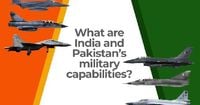In the wake of Operation Sindoor, which resulted in the killing of 100 terrorists on Pakistani soil, tensions between India and Pakistan have escalated dramatically. The air is thick with the threat of a full-scale military conflict, and while India has asserted its military might with precision strikes, Pakistan is reportedly preparing to retaliate.
On Wednesday morning, May 7, 2025, India carried out multiple missile attacks on parts of Pakistan and Pakistan-administered Kashmir, killing at least 26 people, including a three-year-old child. India has claimed its Operation Sindoor targeted nine sites with “terrorist infrastructure.” In response, Pakistan has claimed it brought down five Indian planes, but India has not commented on this claim. Local officials report that at least 10 civilians have been killed in Indian-administered Kashmir due to Pakistani fire since that morning.
According to Pakistan’s armed forces, Indian missiles struck six locations, including four places in Punjab province—the first time that India has hit Pakistan’s most populous state since the 1971 war between the neighbors. The remaining two places targeted were Muzaffarabad and Kotli, both in Pakistan-administered Kashmir. India claims that it also struck a seventh location—Bhimber, also located in Pakistan-administered Kashmir.
The attacks are India’s response to a deadly attack on tourists on April 22, 2025, in which gunmen killed 25 tourists and a local pony rider in the scenic town of Pahalgam, in Indian-administered Kashmir. Witness accounts indicated that the attackers separated the men from the women and attempted to pick non-Muslims as their targets. The gunmen subsequently escaped, and Indian security forces are yet to find them 16 days later.
Seventy-eight years after the partition of British India, the two nations remain bitter foes, now armed with nuclear weapons. The Muslim-majority Kashmir region, a former princely state, has been in dispute since the partition. India, Pakistan, and China each control a part of Kashmir, with India claiming all of it and Pakistan claiming the part administered by India. The two countries have gone to war four times, with numerous cross-border skirmishes and escalations, including one in 2019 after at least 40 Indian soldiers were killed in a suicide attack claimed by the Pakistan-based armed group, Jaish-e-Muhammad.
According to Global Firepower’s 2025 military strength rankings, India is the fourth-strongest military power in the world, while Pakistan is ranked 12th. India spent $86 billion on its military in 2024, or 2.3 percent of its GDP, compared to Pakistan’s $10.2 billion, or 2.7 percent of its GDP. India’s total military strength is 5,137,550 personnel, which is almost three times larger than Pakistan’s 1,704,000.
India possesses 2,229 military aircraft compared to Pakistan’s 1,399. In terms of ground forces, India has 3,151 combat tanks, while Pakistan has 1,839. The naval capabilities also reflect a significant disparity; India’s navy covers nearly 6,100 kilometers of coastline with 293 naval assets, while Pakistan’s navy covers 1,046 kilometers with 121 vessels.
In the realm of nuclear arsenals, the International Campaign to Abolish Nuclear Weapons (ICANW) reported in 2023 that India holds over 180 nuclear weapons, having spent $2.7 billion on its nuclear program, while Pakistan holds over 170 nuclear weapons, with a budget of $1 billion for its nuclear arsenal.
The last significant military confrontation between the two nations occurred in 2019, when U.S. officials detected enough movement in the nuclear arsenals of both nations to raise alarms. Secretary of State Mike Pompeo worked the phone to convince each side that the other was not preparing for nuclear war. Six years later, the stakes are even higher, with military alliances in the region having shifted dramatically.
India, traditionally nonaligned, has been strengthening its military ties with the United States and other Western suppliers, reducing its reliance on Russian arms. Meanwhile, Pakistan, whose relevance to the U.S. has diminished since the end of the war in Afghanistan, has turned to China for the majority of its military purchases, which now constitute about 80 percent of its arms imports.
This changing landscape has injected superpower politics into South Asia’s longest-running conflict. The United States has cultivated India as a partner in countering China, while Beijing has deepened its support for Pakistan. As India takes military action against Pakistan, it has had the United States firmly on its side, a dynamic that complicates the already volatile situation.
Prime Minister Narendra Modi of India spoke with both President Trump and Vice President JD Vance in the immediate aftermath of the April 22 terrorist attack in Kashmir. The strong backing voiced by Trump administration officials was perceived by many in New Delhi as a green light for India’s plan to retaliate against Pakistan, even as U.S. officials urged restraint.
As tensions rise, the potential for miscalculation looms large. U.S. officials worry that with hyper-nationalism in both India and Pakistan, where two well-stocked militaries operate in close proximity, even the smallest of mistakes could lead to catastrophic escalations. “A crisis where you have cross-border airstrikes and an aerial dogfight carries significant escalation risks,” said Lyndsey Ford, a former U.S. defense official.
As the world watches the situation unfold, the need for diplomatic channels to remain open becomes ever more critical. Both countries possess enough firepower to cause catastrophic damage, and while India holds a decisive edge militarily, analysts caution against underestimating Pakistan, which continues to invest in key defense areas. Diplomacy remains the key to avoiding further escalation and ensuring regional peace.


